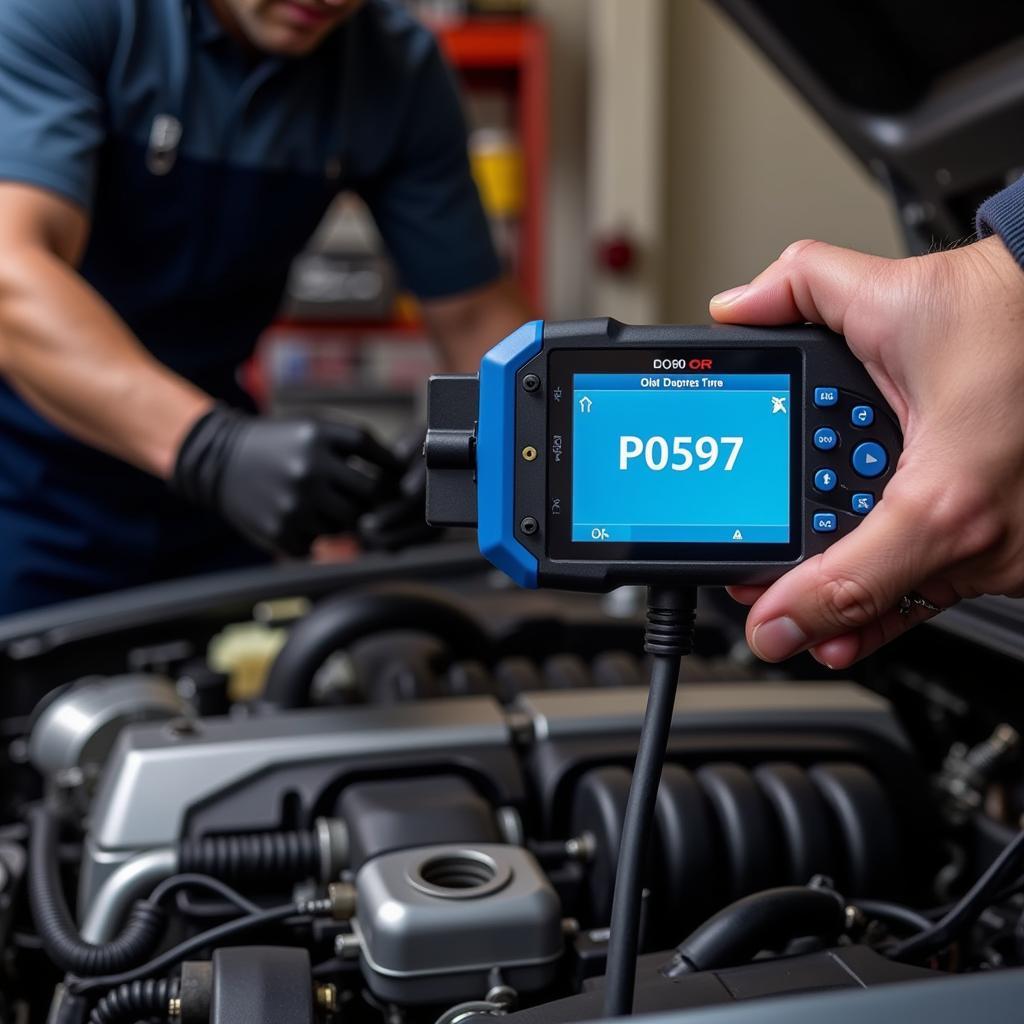The OBD2 code P0597 signals a problem with your vehicle’s thermostat heater control circuit. This code indicates that the power supply to the thermostat heater is outside the acceptable range set by your car’s engine control module (ECM). Ignoring this code could lead to poor fuel economy, slow engine warm-up, and potentially more serious engine problems down the line. This guide will delve deeper into the P0597 code, explaining its causes, symptoms, diagnostic procedures, and potential solutions.
What Does the P0597 Code Mean?
The P0597 code specifically indicates that the voltage supply to the thermostat heater is not within the range expected by the ECM. This usually points to an electrical fault within the heater control circuit, but it can occasionally be a symptom of a faulty thermostat itself.
Modern vehicles use electronically controlled thermostats for greater efficiency and faster engine warm-up times. The thermostat heater plays a crucial role in achieving this by allowing the thermostat to open faster, even when the engine coolant is still cold.
Common Causes of OBD2 Code P0597
Several factors can trigger the P0597 code. The most common culprits include:
- Faulty thermostat: A malfunctioning thermostat, particularly in the heater element, is a leading cause of this code.
- Damaged wiring or connectors: Frayed, broken, or corroded wires and loose or dirty connectors in the thermostat heater control circuit can disrupt the voltage supply.
- Blown fuse: A blown fuse in the circuit can interrupt power to the thermostat heater.
- Faulty engine coolant temperature sensor (ECT sensor): Although less common, a faulty ECT sensor can send incorrect temperature readings to the ECM, potentially leading to a P0597 code.
- Faulty ECM: In rare cases, a malfunctioning ECM might incorrectly flag the P0597 code.
Recognizing the Symptoms of a P0597 Code
While the check engine light illuminating on your dashboard is a definite indicator, other symptoms might surface alongside the P0597 code, including:
- Engine overheating: This is a serious issue and indicates a problem beyond just the thermostat heater.
- Poor fuel economy: The engine might consume more fuel than usual, especially during shorter trips.
- Fluctuating engine temperature: You might notice the engine temperature gauge fluctuating erratically.
- Decreased engine performance: The engine might feel sluggish, particularly during acceleration.
- Heater taking longer to warm up: The car’s heater might take longer to provide warm air during colder temperatures.
Diagnosing the P0597 Code: A Step-by-Step Approach
Accurately diagnosing the underlying cause of the P0597 code is crucial for effective repair. Here’s a systematic approach:
- Retrieve OBD2 Codes: Begin by connecting an OBD2 scanner to your vehicle’s diagnostic port and retrieve all stored codes.
- Inspect the Thermostat and Wiring: Visually examine the thermostat housing and wiring harness for any visible damage, such as cracks, burns, or loose connections.
- Test the Thermostat Heater: Use a multimeter to test the thermostat heater for continuity and resistance. This will determine if the heater element is functioning correctly.
- Check the Voltage Supply: With the ignition on, check for battery voltage at the thermostat heater connector.
- Inspect the ECT Sensor: Test the ECT sensor for proper resistance and signal output.
- Check the Fuses: Locate and inspect the fuses associated with the thermostat heater control circuit for any blown fuses.
- Consult a Professional Mechanic: If you’re unable to pinpoint the cause or are uncomfortable performing these diagnostics, it’s best to consult a qualified mechanic.
 OBD2 Scanner Diagnosing P0597 Code
OBD2 Scanner Diagnosing P0597 Code
Addressing the P0597 Code: Possible Solutions
The solution to the P0597 code depends entirely on the diagnosed cause:
- Replace the Thermostat: If the thermostat is faulty, replacement is usually the most effective solution.
- Repair or Replace Wiring and Connectors: Any damaged wiring or connectors within the circuit should be repaired or replaced as needed.
- Replace Blown Fuse: A blown fuse needs to be replaced with a new one of the correct amperage.
- Replace ECT Sensor: If the ECT sensor is faulty, it will need to be replaced.
- Consult a Mechanic for ECM Issues: If the ECM is suspected as the culprit, it’s best to consult a qualified mechanic for further diagnosis and potential reprogramming or replacement.
2005 bmw obd2 p0597
Frequently Asked Questions
1. Can I still drive with a P0597 code?
While your car might still be drivable, it’s not recommended to ignore the P0597 code. Driving with a faulty thermostat heater can impact fuel economy and potentially lead to more severe engine problems.
2. How much does it cost to fix a P0597 code?
The repair cost varies depending on the underlying cause. A simple fuse replacement might cost as little as $10, while a thermostat replacement could range from $100 to $300.
3. How do I prevent the P0597 code from recurring?
Regular vehicle maintenance, including coolant flushes and inspections of the cooling system, can help prevent issues that might trigger this code.
4. Can a faulty battery cause a P0597 code?
While a weak battery might contribute to electrical problems, it’s unlikely to directly cause a P0597 code.
5. What is the difference between the P0597 and P0598 codes?
Both codes relate to the thermostat heater control circuit, but the P0598 code specifically indicates a high voltage reading in the circuit, while the P0597 indicates the voltage is outside the acceptable range.
Need More Help with Your P0597 Code?
The P0597 code, while seemingly minor, can signal underlying problems within your vehicle’s cooling system. Addressing this code promptly ensures optimal engine performance, fuel efficiency, and prevents potential long-term damage. If you’re dealing with a P0597 code, contact our team of experts at OBDFree. Our team is available 24/7 via WhatsApp: +1(641)206-8880 or Email: [email protected] to provide personalized guidance and assistance.

